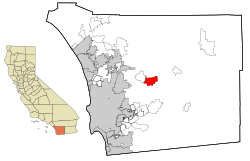2020
The 2020 United States census reported that San Diego Country Estates had a population of 10,395. The population density was 619.3 inhabitants per square mile (239.1/km2). The racial makeup of the CDP was 78.5% White, 1.1% African American, 0.9% Native American, 2.4% Asian, 0.3% Pacific Islander, 4.3% from other races, and 12.6% from two or more races. Hispanic or Latino of any race were 16.5% of the population. [13]
The census reported that 99.9% of the population lived in households, 0.1% lived in non-institutionalized group quarters, and no one was institutionalized. [13]
There were 3,554 households, out of which 34.9% included children under the age of 18, 70.6% were married-couple households, 5.0% were cohabiting couple households, 14.2% had a female householder with no partner present, and 10.2% had a male householder with no partner present. 12.9% of households were one person, and 6.5% were one person aged 65 or older. The average household size was 2.92. [13] There were 2,934 families (82.6% of all households). [14]
The age distribution was 23.6% under the age of 18, 6.8% aged 18 to 24, 24.1% aged 25 to 44, 28.9% aged 45 to 64, and 16.6% who were 65 years of age or older. The median age was 41.6 years. For every 100 females, there were 99.4 males. [13]
There were 3,627 housing units at an average density of 216.1 units per square mile (83.4 units/km2), of which 3,554 (98.0%) were occupied. Of these, 90.8% were owner-occupied, and 9.2% were occupied by renters. [13]
In 2023, the US Census Bureau estimated that the median household income was $134,639, and the per capita income was $54,311. About 0.8% of families and 1.7% of the population were below the poverty line. [15]
2010
At the 2010 census San Diego Country Estates had a population of 10,109. The population density was 599.9 inhabitants per square mile (231.6/km2). The racial makeup of San Diego Country Estates was 9,107 (90.1%) White, 91 (0.9%) African American, 90 (0.9%) Native American, 147 (1.5%) Asian, 34 (0.3%) Pacific Islander, 276 (2.7%) from other races, and 364 (3.6%) from two or more races. Hispanic or Latino of any race were 1,126 persons (11.1%). [16]
The census reported that 10,096 people (99.9% of the population) lived in households, 13 (0.1%) lived in non-institutionalized group quarters, and no one was institutionalized.
There were 3,441 households, 1,380 (40.1%) had children under the age of 18 living in them, 2,479 (72.0%) were opposite-sex married couples living together, 253 (7.4%) had a female householder with no husband present, 142 (4.1%) had a male householder with no wife present. There were 145 (4.2%) unmarried opposite-sex partnerships, and 29 (0.8%) same-sex married couples or partnerships. 421 households (12.2%) were one person and 154 (4.5%) had someone living alone who was 65 or older. The average household size was 2.93. There were 2,874 families (83.5% of households); the average family size was 3.17.
The age distribution was 2,559 people (25.3%) under the age of 18, 832 people (8.2%) aged 18 to 24, 2,208 people (21.8%) aged 25 to 44, 3,376 people (33.4%) aged 45 to 64, and 1,134 people (11.2%) who were 65 or older. The median age was 41.1 years. For every 100 females, there were 101.1 males. For every 100 females age 18 and over, there were 98.0 males.
There were 3,686 housing units at an average density of 218.8 per square mile, of the occupied units 3,056 (88.8%) were owner-occupied and 385 (11.2%) were rented. The homeowner vacancy rate was 1.5%; the rental vacancy rate was 4.0%. 8,787 people (86.9% of the population) lived in owner-occupied housing units and 1,309 people (12.9%) lived in rental housing units.



